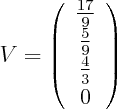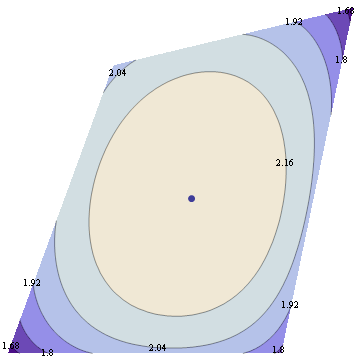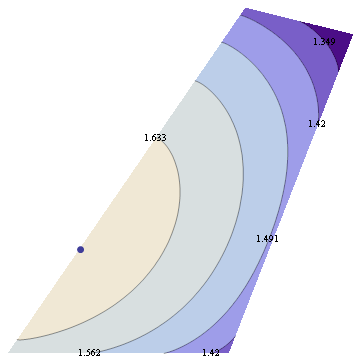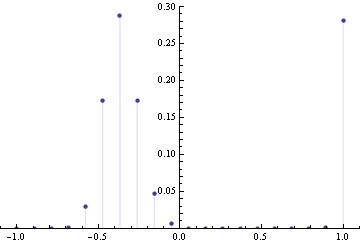I've started a new job at MyStrands.com, looking at mining financial data.
I also applied to Wolfram Research at the same time, but they were too slow to reply. As part of WRI application, I've put together some prior work, I think these are good examples of the things you can use Mathematica for
Tuesday, April 01, 2008
Monday, February 11, 2008
Which DPI to use for scanning papers?
Here's a side to side comparison of 150 vs. 300 vs. 600 DPI scan viewed at 400% magnification. On a local library scanner, 600 DPI black-and-white takes twice as slow to scan as 300 DPI, without significant improvement in quality
Wednesday, February 06, 2008
Strategies for organizing literature
Newton once wrote to Hooke: "If I have seen further it is by standing on the shoulders of giants". It's true nowdays more than ever, and since there's such a huge volume of literature that is electronically searchable, the hard part isn't finding previous work, but remembering where you have found it.
Here's the strategy I use, which relies mainly on CiteULike and Google Desktop, what are some others?
I do similar thing with books, in addition to scanning every technical book that I spend more than a couple of hours reading. With double-sided scans, you can average 4 seconds per page, so well worth the time investment. In addition, book scanning has a kind of meditation effect.
To find some result, ideally I remember the author or tag you put it under, then I use CiteULike search feature. If that fails, use Google Desktop to search through pdf's and web history.
What strategy do you use?
Here's the strategy I use, which relies mainly on CiteULike and Google Desktop, what are some others?
- Use Slogger and "Save As" to save every webpage and pdf I look at, put the pdf's online for ease of access and sharing.
- For more important papers, add an entry to CiteULike with a small comment
- When common themes emerge (like resistance networks or self-avoiding walk trees), go over papers in that area and make sure they share a tag or group of tags
- For papers that are revisited, use "Notes" section for that paper in CiteULike to save page numbers of every important formula or statement in the paper.
- Finally, once a particular theme comes up often enough, review all the papers in that topic, write a mini-summary, put it in the "Notes" section of the oldest paper in that category
I do similar thing with books, in addition to scanning every technical book that I spend more than a couple of hours reading. With double-sided scans, you can average 4 seconds per page, so well worth the time investment. In addition, book scanning has a kind of meditation effect.
To find some result, ideally I remember the author or tag you put it under, then I use CiteULike search feature. If that fails, use Google Desktop to search through pdf's and web history.
What strategy do you use?
Friday, February 01, 2008
Cool formula
Pi comes up in the most unexpected places. Here's an application to walk counting that involves it.
Suppose you have a chain of length n. How many walks of length k are there on the chain? For instance, for a chain of length 5, there are 5 paths of length 0 (start at each vertex and don't go anywhere), 8 of length 1 (traverse each edge either left-right or right-left), 14 of length 2 (8 walks that change direction once, 6 walks that don't change direction) etc.
Curiously enough, there's an explicit formula for this

For example, to find the number of walks of length 2 in a chain of length 5, plug n=5, k=2 into formula above, and get

Which is 14.
Notebook, web version
Suppose you have a chain of length n. How many walks of length k are there on the chain? For instance, for a chain of length 5, there are 5 paths of length 0 (start at each vertex and don't go anywhere), 8 of length 1 (traverse each edge either left-right or right-left), 14 of length 2 (8 walks that change direction once, 6 walks that don't change direction) etc.
Curiously enough, there's an explicit formula for this
For example, to find the number of walks of length 2 in a chain of length 5, plug n=5, k=2 into formula above, and get
Which is 14.
Notebook, web version
Monday, January 28, 2008
Russian Captcha revisited
A few weeks ago , I brought up a Russian CAPTCHA that asks to find resistance between end-points in a version of Wheatstone bridge in order to access a forum
There's been some discussion of this problem on Reasonable Deviations blog, with Vladimir Zacharov writing up a general solution for this circuit using two Kirchhoff's (Kirkhoff) laws and one Ohm's law directly .
For larger circuits, this approach gets exponentially more tedious since you get an equation for every loop in the circuit. But apparently you can ignore most of them and look only at "fundamental loops".
An alternative approach is to use one Kirchhoff law and one Ohm's law. Note that:
1) Current across an edge is proportional to voltage drop divided by resistance
2) Net current at each node is 0, (not counting external current)
Hence, for net current at i'th node we get

Here g's are conductances on edges. This is just a set of linear equations, so you can rewrite them as

where L is the combinatorial Laplacian of the graph with conductances being edge weights. We inject 1 Amp at node 1 (A), extract 1 Amp at node 4 (B), and solve for voltages.

Use your favourite method to solve this linear system. For instance, the following is a solution:

Since current is 1, voltage drop is the same as resistance, hence 17/9 is the answer.
Linear resistor networks turn out to be an amazingly rich subject with connections to many other areas, as can be seen from other ways of solving this problem
- Combinatorics 1: add an edge from 1 to 4 with conductance 1. Resistance is the weighted sum of spanning trees containing new edge divided by the weighted sum of all spanning trees (weighted by product of edge conductances). Formula 4.27 of Wu
- Combinatorics 2: resistance is the determinant of combinatorial Laplacian with 1st/4th row/column removed divided by determinant of said Laplacian with 1st column/row removed. Formula 6 of Bapat and 4.34 of Wu
- Probability Theory 1: Resistance is 1/(cd) where c is conductance of node 1 (sum of incoming edge conductances), d is the probability of random walker starting at node 1 reaching node 4 before coming back to node 1, with node transition probabilities defined by formula 12 in Klein. Formula 13 of Klein
- Probability Theory 2: Add an edge from 1 to 4 with conductance 1. Resistance is the odds of random spanning tree on the graph containing this edge, where probability of each spanning tree is proportional to the product of edge conductances. Follows from formula 4.27 of Wu
- Markov Chain simulation: create a Markov chain with 1 and 4 being trapping states, and transition probabilities defined in previous method. Start with all probability in state 1, let the mass escape once, then simulate Markov chain till convergence. Resistance is 1 divided by mass in node 4 after convergence. Section 1.2.6 of Doyle
- Circuit transformation rules: use star-triangle, parallel and series laws to simplify the circuit to a single resistor. Page 44 of Bollobas. Note that two of these transformation rules have an analogue in graphical models, sections 4.4,4.5 of Sokal.
- Optimization Theory: Resistance is R in the following
 Corollary 5, Chapter 9 of Bollobas
Corollary 5, Chapter 9 of Bollobas
Friday, January 25, 2008
Expectation Maximization for Gaussian Mixtures demo
I was going to post this to Wolfram's Demonstrations website, but then I realized it doesn't fit some technical format limitations, so I'm posting it here.
notebook
It's a demonstration of Expectation-Maximization algorithm, you need Mathematica or free Mathematica Player to run it.
Expectation-Maximization algorithm tries to find centers of clusters in the data. It first assigns each point to some random cluster, each cluster center to random position on the plane, then iterates E and M steps. E-step updates cluster center to be the mean of all datapoints assigned to that cluster, M-step updates each datapoint to be assigned to the cluster whose center is closest to this datapoint. Bold numbers indicate current cluster centers, small numbers indicate datapoints and their current cluster assignment. You can view it as a method of finding approximate maximum likelihood fit of a Gaussian mixture with fixed number of Gaussians and identity covariance matrix. Press "E-step" and "M-step" in alternation to see the algorithm in action.

notebook
It's a demonstration of Expectation-Maximization algorithm, you need Mathematica or free Mathematica Player to run it.
Expectation-Maximization algorithm tries to find centers of clusters in the data. It first assigns each point to some random cluster, each cluster center to random position on the plane, then iterates E and M steps. E-step updates cluster center to be the mean of all datapoints assigned to that cluster, M-step updates each datapoint to be assigned to the cluster whose center is closest to this datapoint. Bold numbers indicate current cluster centers, small numbers indicate datapoints and their current cluster assignment. You can view it as a method of finding approximate maximum likelihood fit of a Gaussian mixture with fixed number of Gaussians and identity covariance matrix. Press "E-step" and "M-step" in alternation to see the algorithm in action.

Thursday, January 17, 2008
Maximum entropy with skewness constraint
Maximum entropy principle is the idea that we should should pick a distribution maximizing entropy subject to certain constraints. Many known distributions come out in this way, such as Gamma, Poisson, Normal, Beta, Exponential, Geometric, Cauchy, log-normal, and others. In fact, there's a close connection between maxent distributions and exponential families -- Darmois-Koopman-Pitman theorem promises that all positive distributions with finite sufficient statistics correspond to exponential families. Recall that exponential families are families that are log-linear in the space of parameters, so in a sense, exponential families are analogous to vector spaces -- whereas vector space is closed under addition, exponential family is closed under multiplication.
After you pick the form of your constraints, the maxent distribution is determined by the value of the constraints. So in this sense, constraint values serve as sufficient statistics, hence by DKP theorem, result must lie in the exponential family determined by form of the constraints.
You can use Lagrange multipliers (see my previous post) to maximize entropy subject to moment constraints. This works to get Normal distribution and Exponential, but if you introduce skewness constraints you get distribution of the form exp(ax+bx^2+cx^3)/Z, which fails to normalize unless c=0, so what went wrong?
This is due to a technical point which doesn't matter for deriving most distributions -- correspondence between maxent and exponential family distributions only holds for distributions that are strictly positive. Also, entropy maximization subject to moment constraints is valid only if non-negativity constraints are inactive. In certain cases, like this one, you must also include nonnegativity constraints, and then the solution fails to have a nice closed form.
Suppose we maximize entropy in a distribution with 6 bins in the interval [-1,1] with constraints that mean=0, variance=0.3 and skewness=0. In addition to normalization constraint, this leaves a 2 dimensional space of valid distributions, and we can plot the space of valid (nonnegative) distributions, along with their entropy.

Now suppose we change skewness constraint to be 0.15 The new plot is below.

You can see that the maximum entropy solution lies right on the edge of the space of valid distributions, hence the nonnegativity constraint must be active at this point.
To get a sense what the maxent solution might look like, we can discretize the distribution, and do constrained optimization to find a solution. Below is the solution for 20 bins, variance=0.4 and skewness=0.23

I tried various values of positive skewness, and that seems to be a general form -- distribution is 0 for positive x's except for a single spike at largest allowable x, for negative x's there's a Gaussian-like hump.
References:
-- Mathematica notebook, web version
-- Justification of MaxEnt from statistical point of view by Tishby/Tichochinsky
After you pick the form of your constraints, the maxent distribution is determined by the value of the constraints. So in this sense, constraint values serve as sufficient statistics, hence by DKP theorem, result must lie in the exponential family determined by form of the constraints.
You can use Lagrange multipliers (see my previous post) to maximize entropy subject to moment constraints. This works to get Normal distribution and Exponential, but if you introduce skewness constraints you get distribution of the form exp(ax+bx^2+cx^3)/Z, which fails to normalize unless c=0, so what went wrong?
This is due to a technical point which doesn't matter for deriving most distributions -- correspondence between maxent and exponential family distributions only holds for distributions that are strictly positive. Also, entropy maximization subject to moment constraints is valid only if non-negativity constraints are inactive. In certain cases, like this one, you must also include nonnegativity constraints, and then the solution fails to have a nice closed form.
Suppose we maximize entropy in a distribution with 6 bins in the interval [-1,1] with constraints that mean=0, variance=0.3 and skewness=0. In addition to normalization constraint, this leaves a 2 dimensional space of valid distributions, and we can plot the space of valid (nonnegative) distributions, along with their entropy.

Now suppose we change skewness constraint to be 0.15 The new plot is below.

You can see that the maximum entropy solution lies right on the edge of the space of valid distributions, hence the nonnegativity constraint must be active at this point.
To get a sense what the maxent solution might look like, we can discretize the distribution, and do constrained optimization to find a solution. Below is the solution for 20 bins, variance=0.4 and skewness=0.23

I tried various values of positive skewness, and that seems to be a general form -- distribution is 0 for positive x's except for a single spike at largest allowable x, for negative x's there's a Gaussian-like hump.
References:
-- Mathematica notebook, web version
-- Justification of MaxEnt from statistical point of view by Tishby/Tichochinsky
Subscribe to:
Posts (Atom)